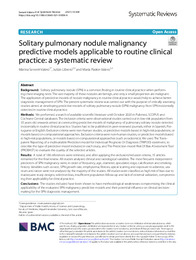Resumen :
Background: Solitary pulmonary nodule (SPN) is a common finding in routine clinical practice when performing
chest imaging tests. The vast majority of these nodules are benign, and only a small proportion are malignant.
The application of predictive models of nodule malignancy in routine clinical practice would help to achieve better
diagnostic management of SPN. The present systematic review was carried out with the purpose of critically assessing
studies aimed at developing predictive models of solitary pulmonary nodule (SPN) malignancy from SPN incidentally
detected in routine clinical practice.
Methods: We performed a search of available scientific literature until October 2020 in Pubmed, SCOPUS and
Cochrane Central databases. The inclusion criteria were observational studies carried out in low-risk population from
35 years old onwards aimed at constructing predictive models of malignancy of pulmonary solitary nodule detected
incidentally in routine clinical practice. Studies had to be published in peer-reviewed journals, either in Spanish, Portuguese
or English. Exclusion criteria were non-human studies, or predictive models based in high-risk populations, or
models based on computational approaches. Exclusion criteria were non-human studies, or predictive models based
in high-risk populations, or models based on computational approaches (such as radiomics). We used The Transparent
Reporting of a multivariable Prediction model for Individual Prognosis Or Diagnosis (TRIPOD) statement, to
describe the type of predictive model included in each study, and The Prediction model Risk Of Bias ASsessment Tool
(PROBAST) to evaluate the quality of the selected articles.
Results: A total of 186 references were retrieved, and after applying the exclusion/inclusion criteria, 15 articles
remained for the final review. All studies analysed clinical and radiological variables. The most frequent independent
predictors of SPN malignancy were, in order of frequency, age, diameter, spiculated edge, calcification and smoking
history. Variables such as race, SPN growth rate, emphysema, fibrosis, apical scarring and exposure to asbestos, uranium
and radon were not analysed by the majority of the studies. All studies were classified as high risk of bias due to
inadequate study designs, selection bias, insufficient population follow-up and lack of external validation, compromising
their applicability for clinical practice.
Conclusions: The studies included have been shown to have methodological weaknesses compromising the clinical
applicability of the evaluated SPN malignancy predictive models and their potential influence on clinical decisionmaking
for the SPN diagnostic management.
|
 La licencia se describe como: Atribución-NonComercial-NoDerivada 4.0 Internacional.
La licencia se describe como: Atribución-NonComercial-NoDerivada 4.0 Internacional.
.png)
